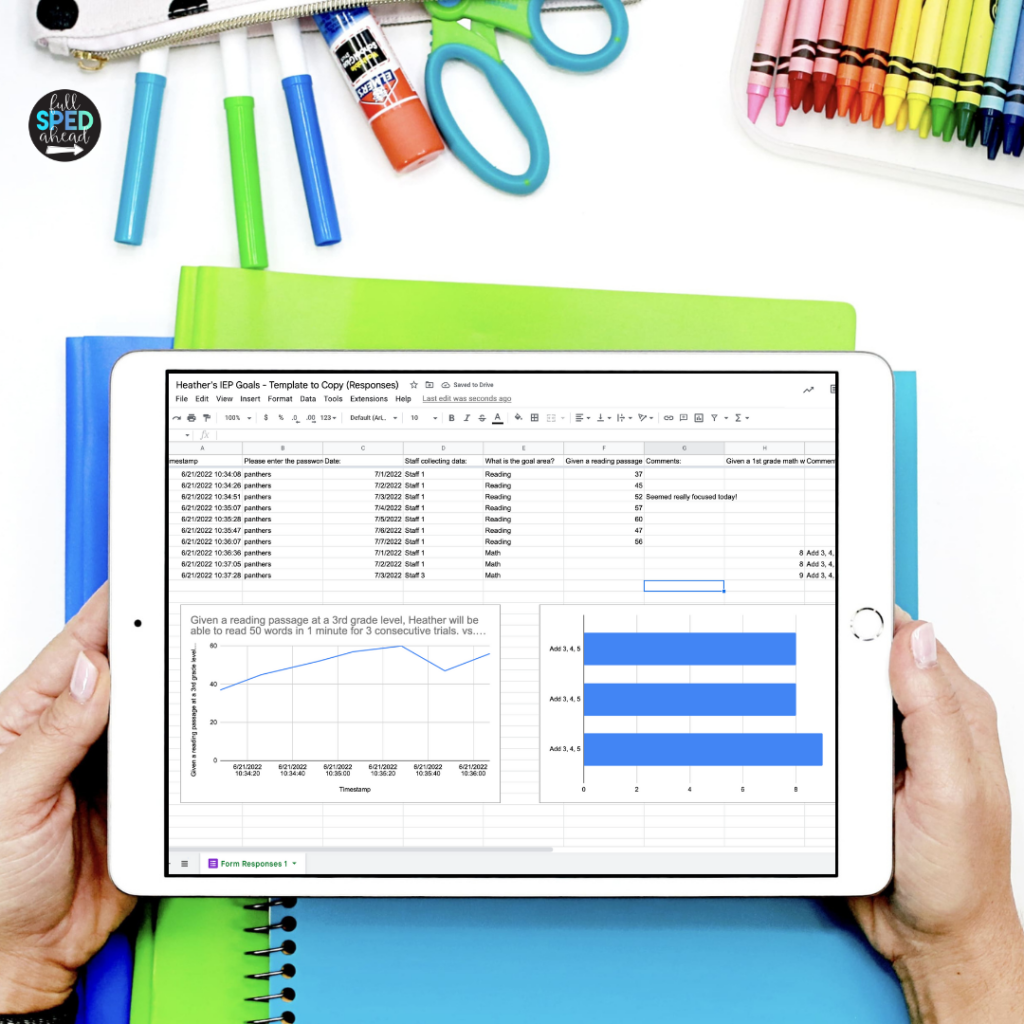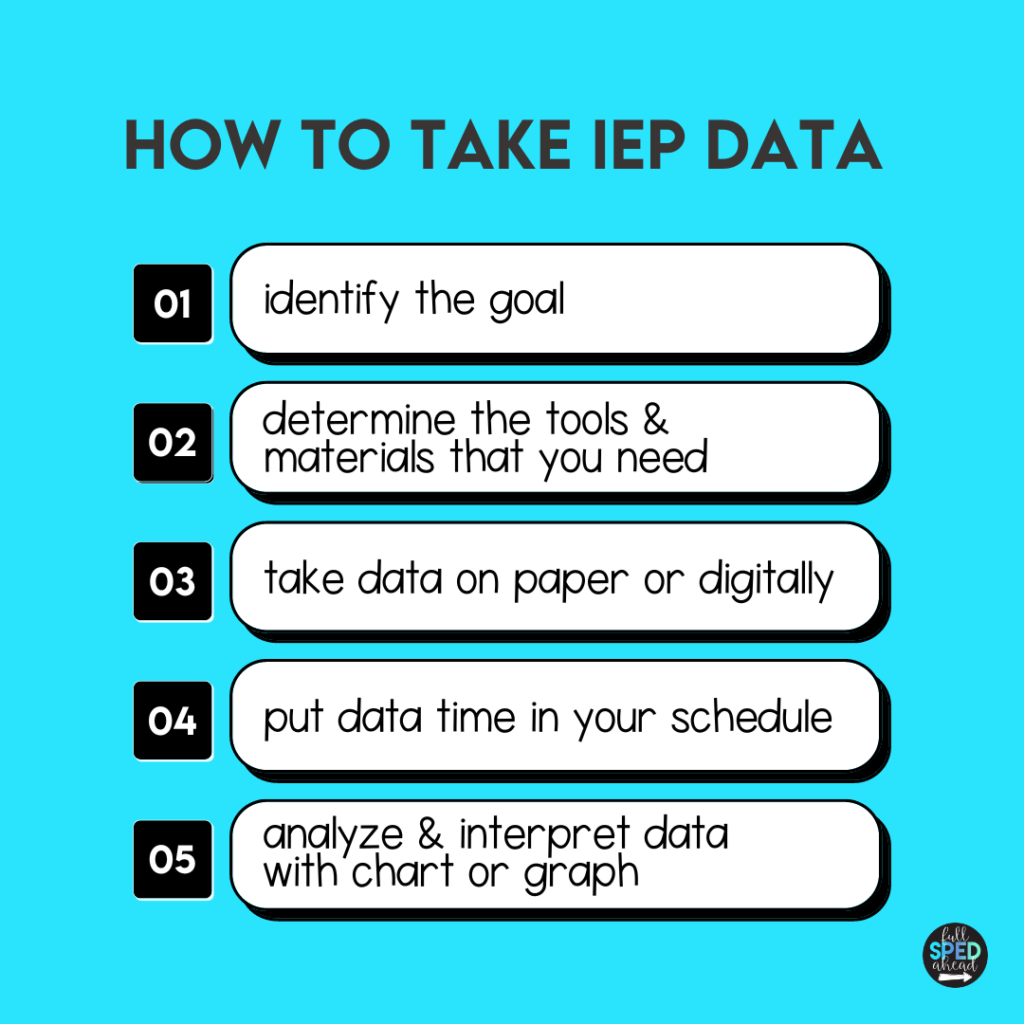As special education teachers, our responsibility extends beyond collecting data on student progress towards IEP goals, we also need to take time for data analysis. This helps inform instructional decisions and ensure that we are meeting the unique needs of each student. However, finding time in a busy week to thoroughly analyze this data can be a daunting task. In this blog post, we’ll discuss the importance of dedicating time to analyze IEP goal data and provide practical strategies for incorporating Data Analysis Fridays into your weekly schedule.
One strategy for ensuring regular analysis is to designate a specific time during your week for this task—such as Data Fridays. Setting aside a dedicated block of time each Friday (or any day that works for your schedule) allows you to review the data you’ve collected throughout the week, reflect on student progress, and make any necessary changes to instructional plans for the upcoming week. You can use this time to organize your data, compare it to past weeks, and identify trends in student performance. It’s also a great opportunity to plan for any upcoming meetings or IEP updates and to ensure your progress monitoring is aligned with each student’s goals.
To make this process even more manageable, consider creating a checklist or template for your data review sessions to ensure consistency. This might include questions such as: Are students meeting their IEP goals at an appropriate rate? Are there specific skills or areas that need additional focus? Do we need to adjust any accommodations or interventions? By making analysis a regular part of your routine, you’ll not only gain valuable insights into student growth but also feel more confident and prepared as you navigate the complexities of special education instruction.
Incorporating Data Analysis Fridays into your weekly schedule can help you stay organized, proactive, and prepared. You can build it into the last hour of your workday or use your planning period to ensure that it becomes a consistent part of your workflow. If possible, collaborate with your paraprofessionals or other support staff to assist in reviewing data and brainstorming solutions. By regularly setting aside time to analyze data, you’ll make better-informed decisions that drive student success, streamline your progress monitoring, and reduce the stress of last-minute data scrambles before meetings or evaluations. Regular data tracking is key to ensuring that your instructional strategies are truly benefiting your students and helping them reach their full potential.
Analyzing IEP goal data allows teachers to make informed, data-driven decisions about their instructional strategies, ensuring each student’s unique needs are met. By regularly reviewing this data, educators can pinpoint specific areas where students are excelling, as well as areas where they may be struggling. This ongoing assessment helps teachers tailor their instruction, whether it’s by modifying lesson plans, implementing new interventions, or providing additional supports.
Furthermore, consistent data analysis fosters a proactive approach, enabling teachers to adjust strategies before small challenges become bigger obstacles, ultimately helping students achieve their goals more effectively and confidently.

Regular analysis helps track student growth over time, offering valuable insights into both their academic and behavioral development. By consistently monitoring progress, teachers can detect patterns and trends that might not be immediately obvious, such as gradual improvements or emerging challenges.
This ongoing tracking provides a comprehensive view of each student’s journey, allowing educators to celebrate successes while identifying specific areas where additional support, targeted interventions, or adjustments in teaching methods may be needed. Moreover, this continuous assessment ensures that no student falls behind unnoticed, empowering teachers to take timely actions that promote steady growth and long-term success.
Consistent data review provides essential insights that enhance communication with parents, administrators, and the IEP team. Having clear, up-to-date data at hand allows educators to present an accurate and detailed picture of a student’s progress, making discussions about their performance more meaningful and focused.
This transparency fosters trust and encourages a collaborative atmosphere where everyone involved—teachers, parents, administrators, and support staff—can work together to refine strategies and interventions.
By sharing data that highlights both successes and areas for improvement, educators can ensure that all parties are aligned in their efforts, leading to more personalized and effective support for each student’s unique needs. This ongoing, data-driven communication is key to making informed decisions that drive student success forward.
IEP goal tracking and data analysis are not just best practices—they are legal requirements under the Individuals with Disabilities Education Act (IDEA). Regularly reviewing and analyzing this data ensures that educators and schools remain in compliance with both federal and state regulations. This process is critical for maintaining accountability, as it demonstrates that the services, accommodations, and supports outlined in each student’s IEP are being properly implemented and monitored.
Beyond simply meeting legal obligations, consistent data review provides concrete evidence of a student’s progress or lack thereof, which is necessary for making informed decisions during IEP meetings. It also serves as a safeguard for the rights of students with disabilities, ensuring they receive the appropriate education and support they are legally entitled to. By staying on top of this requirement, schools and teachers not only fulfill their legal responsibilities but also foster a structured, responsive educational environment that prioritizes each student’s success.
Set aside time each Friday specifically for data review and interpreting. Dedicate the last hour of the school day or another convenient time to review and analyze the data you’ve collected throughout the week. Having a consistent, scheduled time ensures that data analysis becomes a regular part of your routine.

Develop a structured routine for analyzing data. This might include reviewing progress on each student’s IEP goals, identifying trends, noting areas of concern, and planning next steps. Having a clear process will make your data analysis sessions more efficient and effective.
Leverage technology to simplify the data analysis process. Digital tools, such as spreadsheets, data tracking software, or specialized IEP apps, can help you organize and analyze data more efficiently. These tools can generate visual representations of student progress, making it easier to identify patterns and areas needing attention.
Consider setting up a weekly data analysis meeting with your special education team. Collaborating with colleagues allows you to share insights, discuss strategies, and provide support to one another. This collaborative approach can enhance the quality of your data analysis and lead to more effective instructional decisions.
Keep a data analysis journal or binder to document your findings and reflections each week. Record observations, trends, and any instructional changes you plan to implement. Reflecting on this documentation can provide valuable insights over time and help you track the impact of your interventions.
Use the insights gained from your data analysis to plan for the upcoming week. Identify specific goals and instructional strategies for each student based on their progress. Having a clear plan in place will help you tailor your instruction to meet the unique needs of your students.
Share relevant data and insights with parents, administrators, and the IEP team. Regular communication ensures that all stakeholders are informed about student progress and can collaborate to support student success. Provide updates during IEP meetings, parent-teacher conferences, or through regular communication channels.
Including time in your week to analyze IEP goal data is essential for supporting student growth and making informed instructional decisions. By implementing practical strategies, such as designating Data Analysis Fridays, creating a structured routine, utilizing data analysis, collaborating with colleagues, documenting and reflecting, planning for the week ahead, and communicating with stakeholders, you can effectively analyze and use IEP goal data to enhance your teaching practice. Prioritizing data analysis not only ensures compliance with legal requirements but also contributes to the overall success and development of your students.
What are you looking for?
COPYRIGHT © 2025 Full SPED Ahead